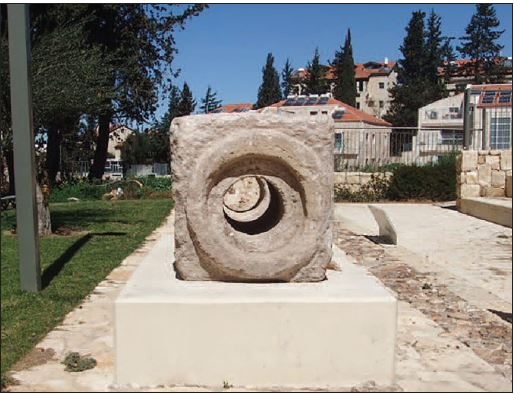‘Playground’ Aqueduct
...dates back 2,000 years
Early on a Shabbat afternoon in a park in the Jerusalem neighborhood of Talpiot, families picnic on clipped lawns or fill benches and tables tucked under tall shade-giving trees that gently swish to and fro in the afternoon breeze.
Just meters from their parents, children chase each other, squealing with delight as they clamber over ancient stone and mortar walls, crawl through the round holes hewn in the center of half a dozen enormous square rocks, and peer through smaller apertures between sections of wall.
A small boy, kippa sitting askew on his head, curly side-locks swinging to and fro, beats his chest in "I am king of the castle" style, whilst taunting his siblings below to "catch me if you can," something they had failed miserably to do up until then.
The boisterous kids are totally oblivious to the fact they are actually having a grand time in what would seem to them to be a natural adventure playground, but is in fact sections of an aqueduct whose history dates back thousands of years.
Running through the park, which is almost completely surrounded by high-rise apartment blocks, are large sections of the recently discovered and renovated Jerusalem Aqueduct, which 2,000 years ago would have been conveying water to their incredible city through a system awash – excuse the pun – with ingenuity and engineering brilliance.
When the children were thirsty from all their running, climbing and merry-making, they rather loudly drank cool water from a nearby water fountain – obviously with no thought of where the refreshing water was coming from or how it had got to their neighborhood, either now or way back then in the times they would be learning about in school or in cheder.
The aqueduct was constructed by the Hasmonean kings, beginning at springs situated near Solomon's Pools south of Bethlehem and over 20 kilometers long. The aqueduct runs along a gentle slope with the water level falling only a meter per kilometer.
Initially, the aqueduct was just an open channel, but around 500 years ago the Ottomans, for better protection of the vital life-supporting flowing water, added a terracotta pipe to the already existing carrier.
As Jerusalem in the modern era expanded, swallowing up huge tracts of open land, and with this water source being one of the main suppliers to meet the needs of the city of Jerusalem, the old water system was replaced a century ago by a new electrically operated system.
Recognising the huge historical and archaeologic importance of the ancient aqueduct, the Israel Antiquities Authority have worked in earnest to expose sections of the aqueduct's remains, such as those renovated in the Talpiot park and in other areas. After undertaking careful studies, more fragile sections have been reburied for their protection and marked for possible renovation in the future.
Not only have the IAA made the impressive system of yesteryear accessible to the public, but also provided on-site historical information in English and Hebrew, so that locals and visitors can share in the wonders of the ingenious water system devised and built by the city's forefathers all those thousands of years ago.
A map, laid out in concrete at the base of one of the renovated sections of the ancient aqueduct in the park, shows the route of the ancient water system as an indented line. With the press of a button inlaid in the ground alongside the map, water begins to flow, filling up the channel at the beginning of the water source that flows through to the city of Jerusalem.
Small children delight at pressing the button and eagerly wait for and gleefully watch the water suddenly swirl along the open narrow channels that run through the mapped out route of the ancient waterway.
Their pet dogs also share in the fun and games, jumping at the chance to lap up some of the water as it gently flows across the few meters of illustrated monumental feats of yesteryear.
A little girl, dressed in her Shabbat finery, stares at a little dog energetically lapping up water.
"Abba, the dog is drinking all the water and there won't be any left for us," she cries out to her rather amused father sitting nearby.









Comments